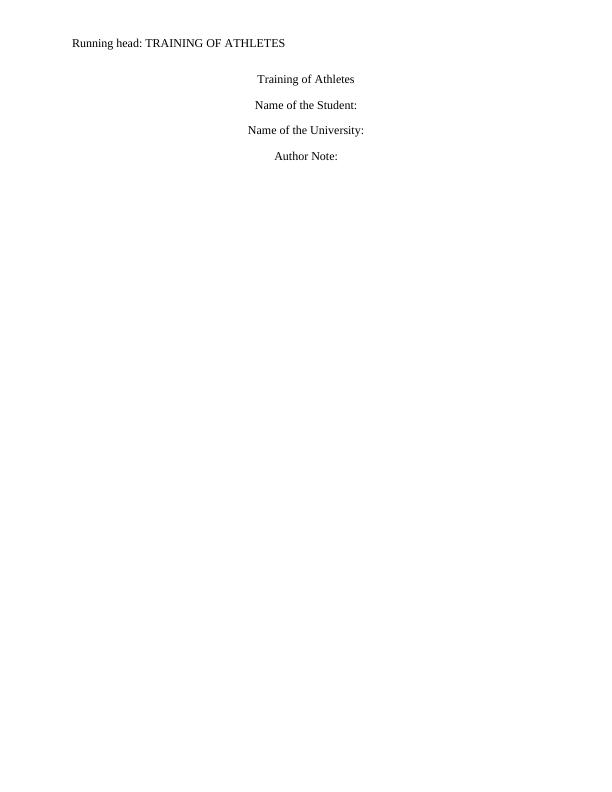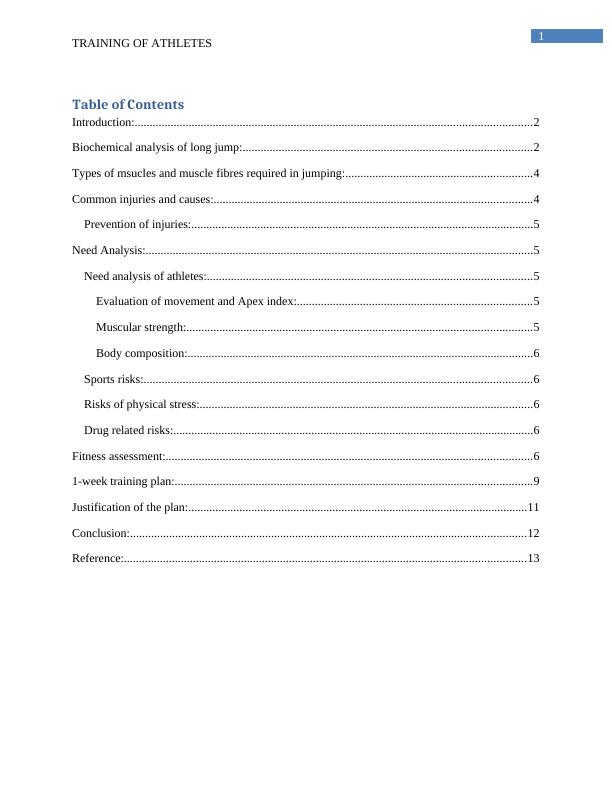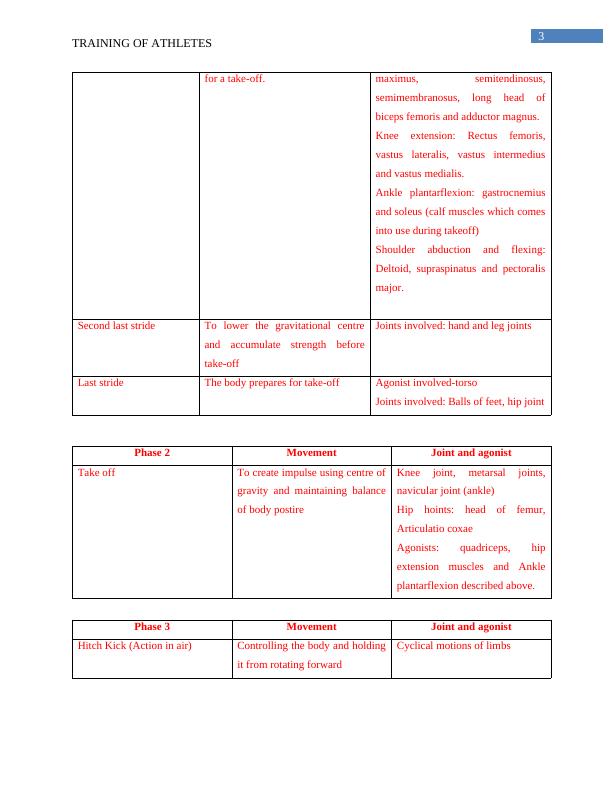Training of Athletes for Long Jump: Needs Analysis, Fitness Assessment, and 1-Week Training Plan
Design a 1 week program for a long jumper to improve speed and power.
14 Pages2925 Words317 Views
Added on 2023-06-15
About This Document
This article discusses the needs analysis, fitness assessment, and 1-week training plan for long jump athletes. It covers topics such as biochemical analysis, muscle types, common injuries, prevention, and sports risks. The article also includes a detailed 1-week training plan with exercises and justification for the plan. Subject: Sports Science, Course Code: N/A, Course Name: N/A, College/University: N/A.
Training of Athletes for Long Jump: Needs Analysis, Fitness Assessment, and 1-Week Training Plan
Design a 1 week program for a long jumper to improve speed and power.
Added on 2023-06-15
ShareRelated Documents
Running head: TRAINING OF ATHLETES
Training of Athletes
Name of the Student:
Name of the University:
Author Note:
Training of Athletes
Name of the Student:
Name of the University:
Author Note:

1
TRAINING OF ATHLETES
Table of Contents
Introduction:....................................................................................................................................2
Biochemical analysis of long jump:................................................................................................2
Types of msucles and muscle fibres required in jumping:..............................................................4
Common injuries and causes:..........................................................................................................4
Prevention of injuries:..................................................................................................................5
Need Analysis:.................................................................................................................................5
Need analysis of athletes:............................................................................................................5
Evaluation of movement and Apex index:..............................................................................5
Muscular strength:...................................................................................................................5
Body composition:...................................................................................................................6
Sports risks:.................................................................................................................................6
Risks of physical stress:...............................................................................................................6
Drug related risks:........................................................................................................................6
Fitness assessment:..........................................................................................................................6
1-week training plan:.......................................................................................................................9
Justification of the plan:.................................................................................................................11
Conclusion:....................................................................................................................................12
Reference:......................................................................................................................................13
TRAINING OF ATHLETES
Table of Contents
Introduction:....................................................................................................................................2
Biochemical analysis of long jump:................................................................................................2
Types of msucles and muscle fibres required in jumping:..............................................................4
Common injuries and causes:..........................................................................................................4
Prevention of injuries:..................................................................................................................5
Need Analysis:.................................................................................................................................5
Need analysis of athletes:............................................................................................................5
Evaluation of movement and Apex index:..............................................................................5
Muscular strength:...................................................................................................................5
Body composition:...................................................................................................................6
Sports risks:.................................................................................................................................6
Risks of physical stress:...............................................................................................................6
Drug related risks:........................................................................................................................6
Fitness assessment:..........................................................................................................................6
1-week training plan:.......................................................................................................................9
Justification of the plan:.................................................................................................................11
Conclusion:....................................................................................................................................12
Reference:......................................................................................................................................13

2
TRAINING OF ATHLETES
Introduction:
Long jump is a track and field event, which combines strength, agility and propelling
power of an athlete where the athlete jumps horizontally before jumping horizintally. The
athletes participating in this event requires to have minimum height like 5 feet minimum, weight
like 65 kgs and other body parameters. The athletes require undergoing rigorous training when
they are weeks away from tournaments they are participating in. The paper is set against a
backdrop of long jump competition where a jumper is preparing for an upcoming summer
competition. The case study also mentions that he has already undergone basic speed and
plyometric training consisting of workouts like plyo pushups and box jumps (uksport.gov.uk,
2018). The trainers would analyse the needs of the jumper and identify the risks he goes through
professionally. Then they would form a fitness assessment of the athlete and go on to plan
session to further train him. The training session would concentrate on each part like biceps. The
trainer would then go on to break each session into a number of workouts. The paper would end
with a justification for opting for the training schedule. The paper also sheds light on intricate
training requirements of the athlete like stretchings, rests and medication. It also includes
pictures showing various workouts of athletes.
Biochemical analysis of long jump:
The biochemical analysis of long jump divides the entire action into four phases, which
involve several biochemical reactions. The biochemical reactions consist of reaction of oxygen
with the glucose in the muscles, which results in the release of energy the athlete requires to
jump. The kidneys release adrenaline or epinephrine, which raises the heart rate and tension
level in the jumper. The hormone also stimulates the sweat glands, which causes the athlete to
sweat to maintain his body temperature and prevent him from getting exhausted. The lungs take
in more oxygen to ensure continuous supply of energy to the muscles, thus incraesing respiration
(uksport.gov.uk, 2018). The four phases are as follows:
Phase 1 Movement Joint and agonist
Approach run It enforces maximum acceleration
for take-off and enables the runner
to use just enough speed required
The flexion and extension of all joints
used.
During hip extension: Gluteus
TRAINING OF ATHLETES
Introduction:
Long jump is a track and field event, which combines strength, agility and propelling
power of an athlete where the athlete jumps horizontally before jumping horizintally. The
athletes participating in this event requires to have minimum height like 5 feet minimum, weight
like 65 kgs and other body parameters. The athletes require undergoing rigorous training when
they are weeks away from tournaments they are participating in. The paper is set against a
backdrop of long jump competition where a jumper is preparing for an upcoming summer
competition. The case study also mentions that he has already undergone basic speed and
plyometric training consisting of workouts like plyo pushups and box jumps (uksport.gov.uk,
2018). The trainers would analyse the needs of the jumper and identify the risks he goes through
professionally. Then they would form a fitness assessment of the athlete and go on to plan
session to further train him. The training session would concentrate on each part like biceps. The
trainer would then go on to break each session into a number of workouts. The paper would end
with a justification for opting for the training schedule. The paper also sheds light on intricate
training requirements of the athlete like stretchings, rests and medication. It also includes
pictures showing various workouts of athletes.
Biochemical analysis of long jump:
The biochemical analysis of long jump divides the entire action into four phases, which
involve several biochemical reactions. The biochemical reactions consist of reaction of oxygen
with the glucose in the muscles, which results in the release of energy the athlete requires to
jump. The kidneys release adrenaline or epinephrine, which raises the heart rate and tension
level in the jumper. The hormone also stimulates the sweat glands, which causes the athlete to
sweat to maintain his body temperature and prevent him from getting exhausted. The lungs take
in more oxygen to ensure continuous supply of energy to the muscles, thus incraesing respiration
(uksport.gov.uk, 2018). The four phases are as follows:
Phase 1 Movement Joint and agonist
Approach run It enforces maximum acceleration
for take-off and enables the runner
to use just enough speed required
The flexion and extension of all joints
used.
During hip extension: Gluteus

3
TRAINING OF ATHLETES
for a take-off. maximus, semitendinosus,
semimembranosus, long head of
biceps femoris and adductor magnus.
Knee extension: Rectus femoris,
vastus lateralis, vastus intermedius
and vastus medialis.
Ankle plantarflexion: gastrocnemius
and soleus (calf muscles which comes
into use during takeoff)
Shoulder abduction and flexing:
Deltoid, supraspinatus and pectoralis
major.
Second last stride To lower the gravitational centre
and accumulate strength before
take-off
Joints involved: hand and leg joints
Last stride The body prepares for take-off Agonist involved-torso
Joints involved: Balls of feet, hip joint
Phase 2 Movement Joint and agonist
Take off To create impulse using centre of
gravity and maintaining balance
of body postire
Knee joint, metarsal joints,
navicular joint (ankle)
Hip hoints: head of femur,
Articulatio coxae
Agonists: quadriceps, hip
extension muscles and Ankle
plantarflexion described above.
Phase 3 Movement Joint and agonist
Hitch Kick (Action in air) Controlling the body and holding
it from rotating forward
Cyclical motions of limbs
TRAINING OF ATHLETES
for a take-off. maximus, semitendinosus,
semimembranosus, long head of
biceps femoris and adductor magnus.
Knee extension: Rectus femoris,
vastus lateralis, vastus intermedius
and vastus medialis.
Ankle plantarflexion: gastrocnemius
and soleus (calf muscles which comes
into use during takeoff)
Shoulder abduction and flexing:
Deltoid, supraspinatus and pectoralis
major.
Second last stride To lower the gravitational centre
and accumulate strength before
take-off
Joints involved: hand and leg joints
Last stride The body prepares for take-off Agonist involved-torso
Joints involved: Balls of feet, hip joint
Phase 2 Movement Joint and agonist
Take off To create impulse using centre of
gravity and maintaining balance
of body postire
Knee joint, metarsal joints,
navicular joint (ankle)
Hip hoints: head of femur,
Articulatio coxae
Agonists: quadriceps, hip
extension muscles and Ankle
plantarflexion described above.
Phase 3 Movement Joint and agonist
Hitch Kick (Action in air) Controlling the body and holding
it from rotating forward
Cyclical motions of limbs

End of preview
Want to access all the pages? Upload your documents or become a member.
